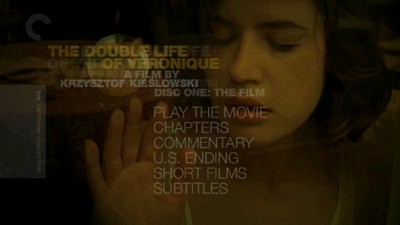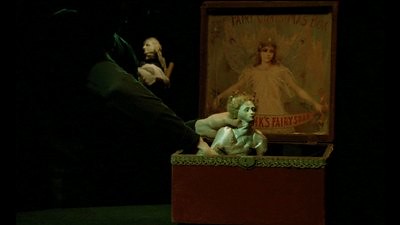
Krzysztof Kieślowski's 1991 feature, The Double Life of Véronique, is a mysterious little movie. While it does tell a story in a semblance of conventional narrative, it's also an emotional jigsaw puzzle, a feat of storytelling agility that puts a lot of trust in its audience. Kieślowski is stingy with the exposition, instead asking us to follow and not to worry about where we are going. Our belief that he will get us somewhere will be its own reward.
Irène Jacob plays Weronika (pronounced Veronika), a Polish girl whose career as a pianist was crushed along with her finger in a car door. She is now in Krakow to pursue singing and by chance ends up earning an important seat on a famous choir. Her artistic pursuit comes with a price, however: it is putting a strain on her relationship with a man she left at home, and it also takes her away from her father, increasing her feelings of anxiety. She has a pervasive sense that something is missing in her life, that she is out of place with the universe.
Cut to a random day on the street of Krakow as a tour bus from France goes through the city square. Looking at the bus, Weronika spots Véronique. Also played by Jacob, Véronique is an exact double for Weronika, something the Polish woman recognizes instantly. The French version doesn't see the other at all, but something has now clicked between them, and they go away from this encounter with a connection, even if one of the pair has not discovered it yet.
Eventually, the story shifts to France and Véronique, a music teacher who shares some of the same concerns about identity as her Polish doppelganger. These become particularly strong after certain events happen to Weronika. A phantom pain is beamed across the European borders, and Véronique is possessed with a grief she cannot put a name to. A sensitive woman, this feeling of loss and dissociation forces her eyes open to the world around her, leading to another chance meeting. While Véronique's class watches a marionette show, the teacher and the puppeteer, Alexandre (Philippe Volter), notice one another, and when the performance is over, Véronique can't get this man out of her head. Shortly after, mysterious packages begin showing up in her mailbox, objects that connect her to Weronika for the audience and Alexandre within the story, and the missing element that Véronique has been searching for begins to come into view. This, too, will have an emotional cost.
Irène Jacob is luminous in the picture. She and Kieślowski were amazing for each other. While they were both excellent apart, their other work never quite compared to their combined efforts on Véronique and, a few years later, Red. Just like other famous actor/director couplings like Gong Li and Zhang Yimou, or even De Niro and Scorsese, they draw performances out of each other that no one else can get. As both versions of Véronique, Jacob manages to make them distinctive while giving the two women enough crossover to make it clear they are of the same spirit. It extends beyond the simple change of hairstyle or langauge. It's in how she emotes, how she carries herself. Weronika starts off more eager, given over to the sheer happenstance of living, whereas Veronique is more melancholy in her search. She maybe feels the love of others more distinctly, but by a tragic turn, also feels more alone because of it.

Kieślowski plays tricks with our perceptions in Véronique. The movie opens with a cityscape that is askew, knocking the viewer off balance. As he pulls back, we discover our point of view has been from a little girl looking out either a window or a kind of skylight, and we're unsure if what we saw was a reflection or the real thing, and even if it was right-side up or upside down. Later in the movie, we look at the world as it passes us in bus windows, imperfections in the glass causing pieces of the landscape to go in and out of distortion, or peering through a clear marble that has stars inside, casting a dreamy glow on the world. Similarly, Véronique's paramour is a puppeteer. When he makes two dolls that look like her and shows her how to manipulate them, it's almost like he is giving her the key to her own destiny, showing her how to be more active in her own life; at the same time, it has ironic results, as the appearance that he may embody the unseen force that wishes to take control (bringing the two Véroniques together or keeping them apart?) has the polarizing effect of pushing Véronique away. Even here, the meaning is purely down to how it strikes you. One doll is being brought to life, the other lays dormant on the table. What does the absence of one half of the equation mean for the identity of the other? Like the many images that double and mirror one another in Véronique, would they have had the same significance if shown all alone?
Though The Double Life of Véronique revels in the unexplained, it's never pretentiously obtuse. The master's touch that Krzysztof Kieślowski gives to the film is to invoke our power of intuition. He is an expert at showing and not telling, but showing us in a way that makes us feel the events rather than intellectualize them. The final shots of The Double Life of Véronique are only a couple of snatched, silent moments. It doesn't put the entire picture into a little box and hand it back to us, telling us everything that the story meant, but yet we somehow walk away with a full sense of those things anyway. It's an experience you never forget, and it's why fans of the film have been so eager to finally see it released on DVD. Like the best memories from important times in our life, to relive and reexamine what Weronika and Véronique go through reignites those feelings and reaffirms the power of human instinct in our interactions with the people around us and, most of all, ourselves.

Originally written November 21, 2006. For technical specs and special features, read the full article at DVD Talk.

No comments:
Post a Comment